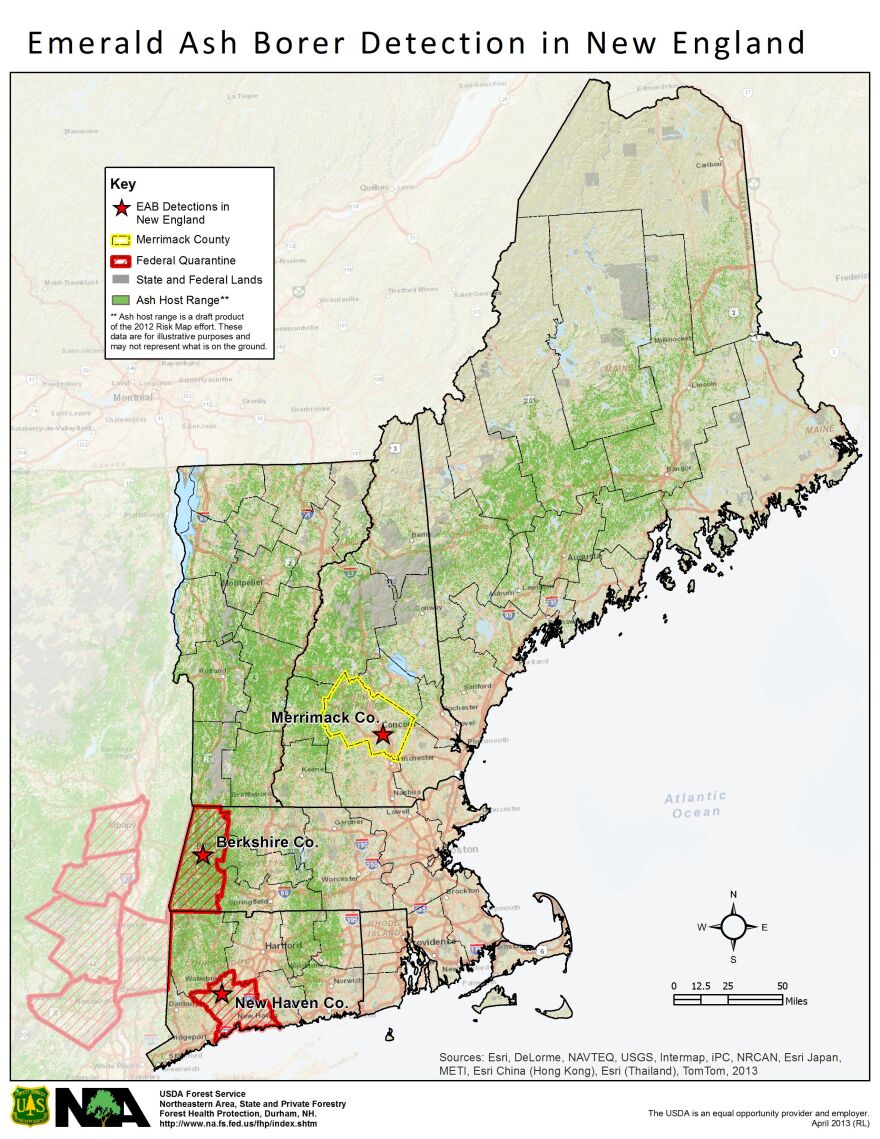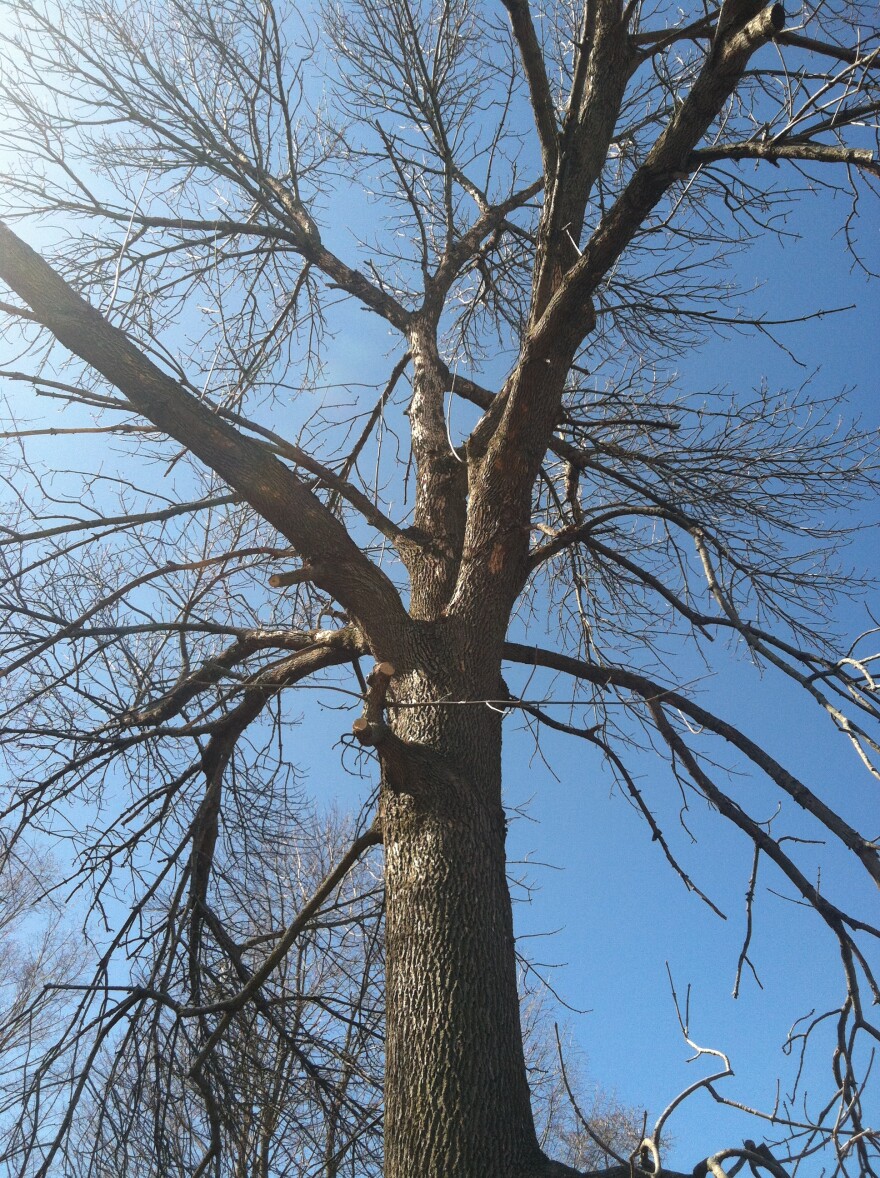Merrimack county is under quarantine. Emerald Ash Borer, an invasive Asian beetle that has killed millions of Ash trees in the Midwest, has been discovered in Concord.
Once the beetle’s population has been established, they can spread incredibly fast, doubling every year. Today the state learned where the patient zero of the New Hampshire infestation can be found.
Kyle Lombard with the New Hampshire Division of Forested Lands has been on the lookout for Emerald Ash Borers since 2002. But he was not expecting to find them here.
“So this is an industrial area with a lot of businesses and a lot of restaurants and hotel,” he explains describing a non-descript parking lot off of Hall Street in Concord, right next to i-93. “And this white Ash happens to be as much as eight inches in diameter and probably as much as 65-70 years old,” Lombard points to the ash that set-off alarm bells for the state’s foresters
“We’re right by the interstate and it might even have been a something just driving by and a beetle just flipped off the truck?” I ask Lombard, trying to explain the unusual location of the infested tree.
“It’s certainly not out of the realm of possibility,” he replies, “but we just don’t know, let’s put it that way.”
Infestation: Newly Discovered, But Not New
To be clear, we also don’t know that this is the first infested tree in New Hampshire, it’s just the first one that the state has found. A resident noticed the sign that often gives the beetle away: frenzied woodpecker activity as the birds feast on the beetle larvae in the bark.
And the infestation in this tree is not a new one. “We could tell that there was at least three or four years of growth over some of the original damage,” Lombard shows me a cutting from the tree and the channels that the beetle larvae have eaten in the trees cambium, “And so we can project that it’s probably three or four years old at a minimum.”
On its own, Emerald Ash Borer moves at a rate of about a half-mile a year. But throughout the history of the country’s decade long infestation, it’s moved in great leaps, because it’s likely been carted around in firewood or nursery stock.

New Hampshire has had a ban on firewood coming into the state since July of 2011. But if Lombard is right, we were infested even before that ban was put in place.
So what does that mean for the roughly 25 million ash trees in the state?
“Initially Emerald Ash Borer comes into an area and it takes a couple of years before things get noticed,” says Cliff Sadof, who works monitoring the beetle for Purdue University in Indiana. “Once you start noticing trees die. The numbers doubles. So you can go from one to two to four to eight to sixteen to thirty-two to sixty-four to one hundred percent in an eight year sequence.”
Stem the Tide?
That’s what happened in the Midwest, where they weren’t expecting it, where the beetle hit much like Old World European diseases devastated Native American populations. But now that the pest has been around for a while, state officials – like Piera Siegert, the state’s etymologist – are hoping that by now we’ve developed some antibodies.
“We’ve come a long way in ten years, and basically the focus of the quarantines is to slow the artificial spread so you can slow ash mortality and give some of these other technologies a chance to catch up,” she explained at a press conference announcing the quarantine on Monday.
The “other technologies” include pesticide applications that can keep individual “high value” trees alive, like stately old trees in city parks.
And of course there’s the time honored technique that Cliff Sadof calls “reuniting old enemies.” There are several species of Asian wasps that consume Emerald Ash Borer. And folks in Michigan have been

experimenting with them.
Also, Sadof says, the beetle can’t kill sapling ash trees. So what tends to happen is the borer sweeps through kills the big trees and moves on. Then as the forest regenerates, the pest returns, he calls it a cat and mouse game.
“But when we introduce the natural enemies that kill the pest, we then have a three level cat and mouse game, we have cat and mouse and corn,” he chuckles.
He says that gives trees more time to grow, and after a few decades a sort of equilibrium point is found, where some trees survive and some don’t, but the tree’s population isn’t destroyed.
Finding the Boundaries, Plotting the Next Move
Back at our putative patient zero, the first infested tree found in Concord, Kyle Lombard says the hope is that we’re still at the low end of the exponential growth curve.
“We’re hoping that we caught this early enough that management strategies will really slow the spread of this thing, to the point where it’s just not leaving this area,” says Lombard. Maybe that’s optimistic, but only time will tell.
So for now, no firewood can leave Merrimack County, and foresters will be working hard to survey a six mile ring around patient zero to find how wide a swath is already affected. Once they know more a plan for how best to proceed will come next.








